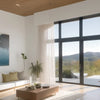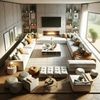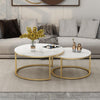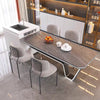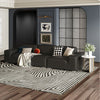Transforming Living Spaces in Malaysia: The Essential Guide to Multifunctional Coffee Tables
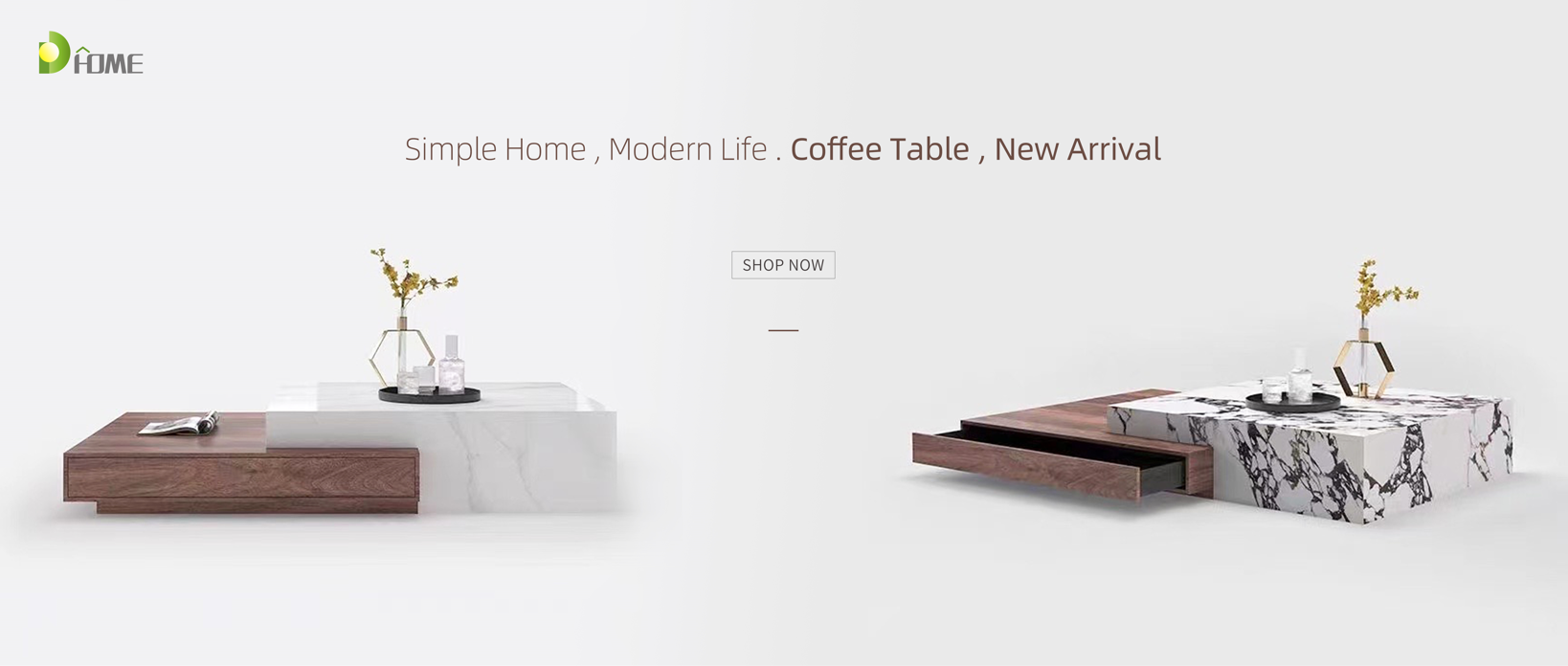
| Table of Contents |
|---|
Introduction

The Transformation of Modern Living Spaces
Modern household interiors are undergoing significant transformations. The traditional segmented layout, where each room serves a specific function such as the living room, dining room, or study, is progressively being replaced by more open and multifunctional spaces. This shift is largely driven by the increasingly flexible and diversified lifestyles of modern families. For instance, with the rise of remote work and diverse home entertainment options, single-function room designs no longer meet the demands of contemporary life. Consequently, open layouts and multifunctional designs have become a trend to accommodate a variety of daily activities.
According to the Southeast Asia Residential Design Trends Report, there has been approximately a 35% increase in demand for homes with open layouts in recent years. In Malaysia, this trend is particularly pronounced, with many new and renovated homes adopting open designs. Such designs not only facilitate interaction among family members but also enhance spatial efficiency. For example, an open-plan living and kitchen area can simultaneously serve as a space for cooking, dining, entertainment, and work, making optimal use of every square meter.

The Central Role of the Coffee Table
In the context of these evolving modern living spaces, the role of the coffee table has also significantly changed. Traditionally used in living rooms to hold beverages, books, and decorative items, coffee tables have gradually become representatives of multifunctional furniture.
Modern coffee table designs are not just decorative pieces; they also incorporate features for storage, work, and entertainment. For instance, some coffee tables are equipped with hidden storage spaces for remote controls, magazines, and other items, helping to keep the living room tidy. Additionally, some models include adjustable tabletops that can be transformed into temporary workstations to accommodate remote working needs. Data indicates that in Malaysia and across Southeast Asia, sales of multifunctional coffee tables have grown by about 30% over the past five years, reflecting consumer preference for this type of furniture.
With their multifunctional design, coffee tables not only maximize space utilization but also cater to the varied needs of modern families, becoming a key element in open and multifunctional living spaces.
Coffee Table Design Trends

Minimalism and Modern Design
Minimalism and modern design are increasingly popular in coffee table styles, emphasizing clean lines and functionality while minimizing unneces
sary decorations to maximize the use of space. This design style is particularly suited to modern households as it not only looks aesthetically pleasing but also helps make spaces appear larger by reducing visual clutter.
In Southeast Asia, minimalist design has gained widespread popularity. For instance, designers in Malaysia have adopted minimalist coffee tables that optimize the use of small apartments and open-plan living spaces with their simple forms and functional layouts. Similarly, many apartment designs in Singapore frequently adopt this style to enhance the overall spatial experience. Data shows that sales of minimalist-style furniture have increased by 20% over the past three years, indicating a strong consumer preference for this design approach.

Material Innovations
As technology advances and consumer demands evolve, coffee table materials are also innovating. Sintered stone, a new material known for its durability and aesthetic appeal, has garnered increasing attention. Sintered stone is created through a process of high-temperature and high-pressure sintering, resulting in a material with extreme hardness and scratch resistance, as well as excellent stain resistance.
In coffee table design, sintered stone offers a robust surface that can be crafted in a variety of textures and colors, achieving high aesthetic effects. For example, many high-end furniture brands in Malaysia have started to extensively use sintered stone in their coffee table production to meet consumer demands for quality and stylish appearance. Additionally, designers in Indonesia are using this material to create unique coffee tables that enhance the product's competitive edge in the market. According to market research reports, the demand for high-end sintered stone furniture has grown by 15% over the past five years.
Functionality and Adjustability
Modern families require furniture that is not only beautiful and durable but also multifunctional and adjustable. Designs for foldable and extendable coffee tables meet these needs perfectly. Such designs provide additional table space when needed and can be folded or tucked away when not in use, saving space.

For instance, some coffee table designs include hidden storage spaces and adjustable tabletops that can easily transform into work desks or dining tables. This flexible design is particularly popular in urban households in Southeast Asia, where living space is often limited and there is a need for adaptable furniture to suit different life scenarios. In Thailand, families are increasingly leaning towards this type of multifunctional furniture to enhance the utility of their small apartments. Data shows that the market for foldable furniture in Southeast Asia has grown by 25% over the past five years, reflecting a strong consumer demand for such multifunctional furniture.
Through these design trends, coffee tables are more than just simple pieces of furniture; they are key elements that enhance both the functionality and aesthetic of living spaces.
Practicality of Multifunctional Coffee Tables
Space-Saving Solutions
In modern home design, saving space and enhancing practicality are paramount. Multifunctional coffee tables not only provide additional storage space but also offer extra seating when needed. For example, many coffee tables now come equipped with hidden storage spaces for remotes, magazines, and other small items, helping to keep the living area tidy. Additionally, some coffee table designs include concealed chairs that can be pulled out when needed, saving space on a regular basis.

In Singapore, where compact apartments are common, many families opt for these multifunctional coffee table designs. Similarly, in Malaysia, families have found that such designs help them maximize the use of their limited living space. Market surveys indicate that in Southeast Asia, coffee tables with storage features have seen a 20% sales growth over the past two years.
Adaptive Designs
Another significant advantage of multifunctional coffee tables is their adaptability, which allows them to be adjusted for different activities. For instance, during family gatherings, coffee tables with extendable tabletops can provide additional space for dining or gaming; during children's playtime, these tables can transform into areas for drawing or playing; and some designs allow for height adjustments, turning them into comfortable workstations.
In Thailand, many families choose these flexible pieces of furniture to accommodate a variety of family activities. Likewise, in the Philippines, many households prefer these designs to meet the diverse needs and activities of family members. Data shows that the demand for adaptable coffee tables continues to grow in the Southeast Asian market, reflecting their broad practicality.
Creative Design Examples
Modern families are increasingly leaning towards creative and practical coffee table designs that not only enhance the functionality of the furniture but also add to the aesthetic of the living space. The island-style coffee table is a prime example, offering ample tabletop space with additional storage shelves or drawers suitable for placing books, decorative items, or office supplies.

Moreover, some designs incorporate movable components, allowing the coffee table to be reconfigured as needed. For instance, designs with rotatable tabletops let users adjust the surface area based on their needs, providing greater flexibility. In markets like Malaysia and Indonesia, these innovative designs have received high consumer acclaim, and sales data also show strong growth.
Through these creative designs, coffee tables not only significantly expand in functionality but also add new visual highlights to modern homes. These designs demonstrate how to maximize functionality and practicality in limited spaces.
Selection and Buying Guide

Choosing the Design Style
When selecting a coffee table, the design style is an important consideration. Each household's living space has its unique style and ambiance, making it crucial to choose a coffee table that complements the overall design. For example, if your living space adopts a modern minimalist style, then a minimalist-designed coffee table with clean lines and a simple appearance would be an ideal choice as it harmonizes with the space.
- Modern Style: For a modern-style home, consider the Soho Coffee Table by AllModern. This table, made from engineered and solid wood, features a sleek design and strong functionality. Its two-tone design and lower storage space suit various modern living room layouts, providing additional storage to maintain tidiness.
- Industrial Style: The coffee table from Biltmore Trunk MFG is a great choice for industrial interiors. Combining metal and wood with rivet accents and vintage-style hardware, it fits perfectly within an industrial decor theme. Its robust appearance and practical storage capabilities make it an ideal choice for industrial-style living spaces.
- Traditional Style: For those who prefer traditional aesthetics, the Yukon Coffee Table by Crate & Barrel is an excellent option. Made from solid acacia wood, it features natural textures and a rustic charm. Its sturdy construction and classic design add warmth and appeal to any traditional-style living room.
- Bohemian Style: If you favor Bohemian decor, the Targua Inlay Coffee Table from Anthropologie is an ideal selection. This handcrafted bone inlay round coffee table not only has a unique appearance but also boasts rich textures and patterns, adding an artistic touch and personality to any space.
- Minimalist Style: For minimalist homes, the Flume Round Coffee Table by Blu Dot is perfect. With its powder-coated steel frame and glass top, this table's design is simple yet elegant, ideally suited for spaces that emphasize functionality and a clean visual style.
Additionally, in Southeast Asia, many families incorporate local cultural elements into their design style, choosing coffee tables made from materials like bamboo or rattan to reflect regional characteristics.
Key Considerations for Purchase
When choosing a coffee table, several key factors should be considered:
- Size: Ensure the coffee table's dimensions are suitable for the room's size and layout. Generally, the height of the coffee table should match the height of the sofa, and its length should be about half the length of the sofa.
- Shape: Different shapes of coffee tables suit different space layouts. Round and oval coffee tables are suitable for smaller spaces and families with children as they are safer without sharp corners; square and rectangular tables provide more tabletop space, suitable for larger rooms.
- Material: The choice of material affects both the aesthetics and durability of the coffee table. Wooden coffee tables are classic and warm, metal coffee tables are modern and stylish, and glass coffee tables appear light and are easy to clean. New materials like sintered stone offer high durability and a variety of design options.
- Functionality: Consider additional features of the coffee table, such as whether storage space or adjustable heights are needed to meet various family needs.
Budget and Investment
Budget is an important consideration when purchasing a coffee table. Higher-priced coffee tables often use higher quality materials and more complex designs, but this does not mean that lower-priced coffee tables cannot meet needs. It is important to find cost-effective products within your budget.
Viewing a coffee table as a long-term investment is reasonable. High-quality coffee tables not only meet functional and aesthetic needs over the long term but also enhance the overall value of the home to some extent. For instance, coffee tables made from durable materials like sintered stone or solid wood, despite their higher initial cost, are a wise investment choice due to their durability and enduring beauty.
In the Southeast Asia region, consumers are increasingly opting for furniture that offers long-lasting durability and multifunctionality. This trend reflects a recognition of the investment value of home furnishings and has driven the popularity of high-quality coffee tables in the market.
With this guide, consumers can make wise choices regarding design style, purchase considerations, and budget, ensuring that the selected coffee table not only meets functional needs but also enhances the overall aesthetics of the living space.
Conclusion

The Crucial Role of Multifunctional Coffee Tables
As we have explored, the evolution of living spaces necessitates furniture that can adapt and morph to meet diverse needs. Coffee tables have transitioned from mere decorative pieces to central fixtures in homes, providing versatile solutions that enhance living spaces both functionally and aesthetically. They are no longer just surfaces for holding items but have become strategic components that reflect the efficiency and design sensibility of a modern home.
Looking Towards the Future
The future of home design promises even greater integration of functionality and style, with coffee tables at the heart of this progression. As household dynamics evolve and environmental awareness rises, expect to see coffee tables that not only adapt to space but also to the environmental and technological needs of tomorrow. Innovative materials and smart features like embedded technology are likely to become standard, offering convenience and sustainability in one package.
These developments ensure that coffee tables remain indispensable in modern homes, blending tradition with cutting-edge design. Their ongoing evolution will undoubtedly continue to captivate and meet the demands of future generations.
By embracing these versatile and adaptive furniture pieces, homeowners can ensure their spaces remain functional, stylish, and prepared for the future. Explore our range of multifunctional coffee tables DPhome COFFEE TABLES that embody these principles, and find the perfect centerpiece for your evolving home space.
FAQs
-
What is multifunctional living?
Multifunctional living involves using adaptable furniture that serves multiple purposes, effectively enhancing the functionality of living spaces. For instance, a living room coffee table that includes hidden storage or expandable features supports this lifestyle by adapting to various household activities. -
How do you make a multi-purpose space?
To create a multi-purpose space, select furniture that can adapt to different activities. Coffee table sets often come with additional seating or surfaces that can be stowed away when not in use, allowing them to serve as both storage solutions and entertainment centers, thereby maximizing the usability of the space. -
What are multifunctional spaces?
Multifunctional spaces are designed to accommodate a variety of activities using flexible furniture solutions. A coffee table with chairs, for example, can convert a typical living room into a dining area or workspace, providing a practical solution for small apartments or homes where space is at a premium. -
How big should a coffee table be?
The appropriate size for a coffee table depends largely on the space available and the layout of the room. A good rule of thumb is choosing a living room coffee table that is roughly two-thirds the length of the sofa and positioned at a comfortable height relative to the seating around it, facilitating easy access and use. -
How much space should be between a couch and a coffee table?
Ideally, there should be about 15 to 18 inches of space between a couch and a coffee table. This spacing ensures there is enough room to move comfortably while keeping essential items within easy reach. This setup is typical with living room table arrangements, balancing functionality and comfort. -
What is the standard height of a coffee table?
The standard height for a coffee table is typically between 16 to 18 inches. This height aligns well with the seat height of most sofas and chairs, making it easy to reach for items without straining, which is particularly important for coffee table sets that are used frequently throughout the day.

